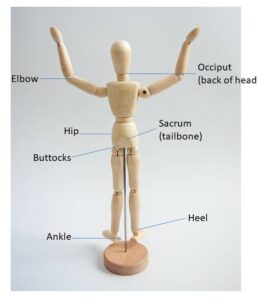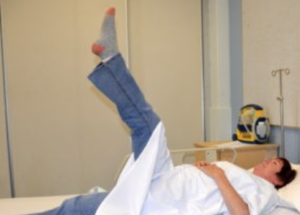When it comes to a lift or a transfer, different terminology is used in different workplaces. A lift refers to using a mechanical device designed to move a client who cannot bear weight on at least one leg, including horizontal or vertical lifts to reposition clients on a bed; the client is incapable of assisting with mobility. A transfer is a shared dynamic and cooperative effort in which the client who is able to bear weight on at least one leg helps the care provider with the transfer.
Assisting with Transfers, Turning and Positioning
Turning and Positioning the Client

Turning a client in bed is an important task of the HCA. It is very important to protect the client’s skin any time they are turned or moved. Friction and shearing can cause skin breakdown and injury. Friction and shearing can also occur when the client slides down in bed. To reduce friction and use a draw sheet when moving a client. When lifting or moving clients in bed use at least two people to assist as often as possible. Never pull on a client’s body part to lift or turn them, as this can cause a serious injury.
Clients should be turned every two hours to prevent development of pressure ulcers (See Fig. 8.2.1). There are a number of positions in which client can be placed. Alternate the positions used to help prevent pressure ulcers and to provide client comfort. Position pillows under bony areas to prevent pressure ulcers. If clients prefer to stay in one particular position, a pillow should be placed under one buttock or hip to prevent pressure ulcers. This pillow can be rotated to the other side with the next position change. For example, the client has a pillow placed under their right buttock at 10 am. With the 12 noon turn and position, the pillow can be moved to under the left buttock.
Before repositioning the client, the HCA should also offer the use of the toilet, bedpan, or urinal. Clients should also be offered a glass of water at this time to ensure proper hydration. Ensure the client’s body is in proper alignment once you are done positioning them, and that pillows are used to support body parts.
Risk Assessment for Safer Client Handling
To prevent and minimize MSI injuries related to client handling activities, a risk assessment must be done to determine a client’s ability to move, the need for assistance, and the most appropriate means of assistance (Provincial Health Services Authority [PHSA], 2010). There are four important areas to assess:
- The client
- The environment
- The healthcare provider
- The organization of the work
Checklist 8.2.1 outlines these four areas of assessment and what to consider prior to positioning, ambulation, and transfers.
Disclaimer: Always review and follow your hospital policy regarding this specific skill.
- The assessment process should not override clinical judgment and client-specific needs as determined by the healthcare team.
- An assessment should be performed before each handling procedure.
- Seek additional help if a procedure requires two or more persons.
- Use assistive devices (gait belts, slider boards, pillows, etc.) to perform the procedure safely.
- Assess the client’s ability to tolerate the movement. Acute pain, shortness of breath, and inability to follow direction will place the healthcare provider and client at risk for injury.
- Always consider the principles of proper body mechanics prior to any procedure, such as raising the head of bed and tucking elbows in to help prevent injuries.
- Avoid lifting shoulders when positioning a client.
- Never lift a client; always use a weight shift to perform the procedure.
- When positioning a client using a sheet, place palms of hands up. A palms-down technique increases risk for injury.
- Vision and hearing loss, and language barriers can make communicating with the client difficult and can result in increased risk for injury.
- Ensure the plan of care is updated regularly.
|
STEP
|
ACTION
|
ADDITIONAL CONSIDERATIONS
|
|
1.
|
Assess your client.
|
There are three areas to assess:
1. Is the client cooperative and able to follow directions? Ask the client to squeeze your hands. Is the behaviour predictable (non-aggressive, fearful, or fatigued)? Is the client able to follow directions with cues?
2. Can the client bear weight? Ask the client to lift their buttocks off the bed (also known as “bridging”), and hold the position for five seconds. The healthcare provider may give cues on how to lift buttocks off the bed.
 After bridging, ask the client to perform a straight leg raise by lifting one leg up off the bed and holding it for five seconds while the other leg is kept bent. Repeat with the opposite leg.

3. Can the client sit up on the side of the bed without support? Can the client sit forward on a chair or the edge of the bed without support?

Risk assessment also involves knowing any activity restrictions associated with recent surgery or injury. |
|
2.
|
Assess your environment.
|
Is there adequate space?
Is available equipment in proper working order? Have all hazards been removed? |
|
3.
|
Assess yourself for readiness to perform procedures.
|
Complete all required training according to health agency regulations.
Wear non-slip footwear. Maintain a neutral spine; do not twist or side bend; and use proper body mechanics when moving or positioning clients. Designate a leader if working in a team to mobilize or position a client. Always use proper weight-shift techniques (side to side, front to back, and up and down). |
|
4.
|
Assess your work organization.
|
Ensure adequate number of caregivers.
Ensure there is enough time to perform the procedure. Take rest breaks and vary activities to promote optimal back health. If the client is complex or bariatric, consult additional resources, seek assistance, and use assistive devices. |
The following are useful resources to help you further develop your understanding of assessment and decision making around client handling activities.
Read the Mobility Decision Support Tool: http://safecarebc.ca/wp-content/uploads/Mobility-Decision-Support-Tool.pdf flowchart, which was provincially developed, to guide decision making about transfers and ambulation.
Watch the Assess Every Time video, which was developed by WorkSafeBC, to review the quick assessment as described in Checklist 8.2.1.
Critical Thinking Exercises
- Name five things the healthcare worker should assess about themselves when considering their own ability to perform a client-handling procedure?
- Vision and hearing impairments, as well as language barriers, are risk factors when performing client-handling procedures. What additional client risk factors should be considered?
Rubbing of two surfaces together, such as the skin rubbing against a sheet.
When skin sticks to a surface, such as a sheet, and the muscles underneath slide in the direction the body moves.
A special linens placed underneath clients to help move lift them in bed.
a container into which bowel and/or bladder elimination may occur. These devices are helpful for people who have mobility issues and have difficulty getting out of bed.
a container or receptacle into which males urinate. Handheld urinals are available to assist patients who have mobility issues.

